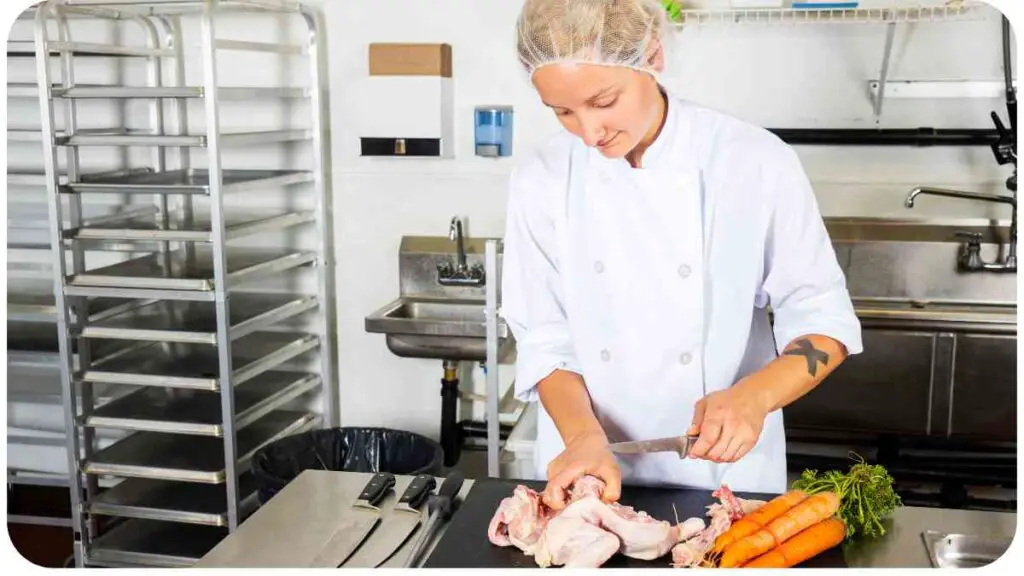Welcome to a comprehensive guide on food safety and understanding cross-contamination. In this article, we will explore the concept of cross-contamination, its potential dangers, and provide practical tips for preventing it both in homes and food service establishments.
As an experienced professional in the field of food safety, I have encountered numerous instances where cross-contamination has had severe consequences. By sharing my expertise and real-world examples, I hope to engage and inform readers on the importance of preventing cross-contamination.
| Takeaways |
|---|
| Cross-contamination is the transfer of harmful microorganisms from one food or surface to another, posing a risk of foodborne illnesses. |
| Common sources of cross-contamination include improper handling of raw and ready-to-eat foods, inadequate cleaning of kitchen surfaces, and poor personal hygiene practices. |
| Preventing cross-contamination at home can be done by separating raw and cooked foods, properly handling raw foods, cleaning and sanitizing surfaces, practicing good personal hygiene, and educating about food allergens. |
| Food service establishments should train staff on proper food handling, use color-coded equipment, separate work areas, store ingredients properly, and regularly clean and sanitize to prevent cross-contamination. |
| Specific foods like meats and poultry, fruits and vegetables, dairy and eggs, grains and legumes, and ready-to-eat foods can all be sources of cross-contamination if not handled correctly. |
| Proper cleaning and sanitizing of kitchen surfaces is essential in preventing cross-contamination. Follow the steps of clearing the surface, washing with hot soapy water, rinsing, sanitizing, and allowing to air-dry or using a clean cloth. |
| Understanding food labels and expiration dates is crucial to avoid consuming expired or contaminated food. Be aware of allergen warnings and proper storage instructions. |
| Further reading resources from health departments and food safety agencies provide additional information on preventing cross-contamination at home and in food service establishments. |
| Frequently asked questions cover topics such as how cross-contamination occurs, symptoms of foodborne illnesses, prevention tips, cleaning frequency, and guidelines for food service establishments. |
2. What is Cross-Contamination?
Before we delve into the details, let’s clarify what cross-contamination entails. Cross-contamination refers to the transfer of harmful microorganisms, such as bacteria, viruses, and parasites, from one food or surface to another. When this transfer occurs, it can lead to foodborne illnesses, posing a significant risk to human health. Various factors contribute to cross-contamination, including improper handling of raw and ready-to-eat foods, inadequate cleaning of kitchen surfaces, and poor personal hygiene practices.
Food preservatives are a topic of concern for many. Understanding their impact on our health is crucial. Learn more about preservatives and their effects to make informed choices when shopping for groceries.
3. The Dangers of Cross-Contamination

Understanding the dangers associated with cross-contamination is crucial for prioritizing food safety. Foodborne illnesses can range from mild discomfort to severe complications, potentially leading to hospitalization or even death.
Children, pregnant women, the elderly, and individuals with compromised immune systems are particularly vulnerable to the consequences of cross-contamination. By taking necessary precautions and implementing proper food safety measures, we can significantly reduce the risk of foodborne illnesses and protect public health.
4. Common Sources of Cross-Contamination
To effectively prevent cross-contamination, it is important to be aware of its common sources. Some key contributors include:
- Raw and cooked foods coming into contact with each other
- Using the same cutting board or utensils for different food items without proper cleaning
- Inadequate handwashing before and after handling food
- Untreated and contaminated water
- Improper storage of cooked and raw foods
- Lack of awareness regarding food allergens and cross-contact
By identifying these sources, we can take targeted measures to minimize the risk of cross-contamination and improve food safety practices.
Ensuring kitchen safety involves more than just proper handling of knives and utensils. Learn effective strategies to prevent slipping and create a safer cooking environment for yourself and your family.
5. Preventing Cross-Contamination at Home
Taking necessary precautions to prevent cross-contamination in our homes is essential for ensuring the safety and well-being of ourselves and our loved ones. Here are some practical tips to follow:
Table 1: Tips for Preventing Cross-Contamination at Home
| Heading | Examples |
| Separate raw and cooked foods | – Use separate cutting boards for meats and vegetables<br>- Store raw and cooked foods separately in the refrigerator |
| Properly handle raw foods | – Wash hands thoroughly before and after handling raw meats<br>- Use separate utensils for handling raw and cooked foods |
| Clean and sanitize surfaces | – Regularly clean countertops, cutting boards, and utensils with hot soapy water<br>- Use a sanitizing solution or bleach solution for added disinfection |
| Practice good personal hygiene | – Wash hands with soap and water for at least 20 seconds<br>- Tie back long hair and avoid touching face or hair while preparing food |
| Educate about food allergens | – Be aware of common food allergens and their potential cross-contact<br>- Clearly label and segregate allergenic foods |
By implementing these practices at home, we can significantly reduce the risk of cross-contamination and promote a healthy and safe eating environment for our families.
6. Preventing Cross-Contamination in Food Service Establishments

Food service establishments, such as restaurants and cafeterias, hold a greater responsibility in ensuring food safety for their customers. Here are some guidelines to prevent cross-contamination in these establishments:
Food expiration dates can be confusing. To avoid consuming spoiled food, it’s essential to understand food expiration dates thoroughly. Educate yourself on this matter to maintain a healthy and safe diet.
Table 2: Guidelines for Preventing Cross-Contamination in Food Service Establishments
| Heading | Examples |
| Train staff on proper food handling | – Conduct regular training sessions on food safety<br>- Emphasize the importance of handwashing and proper hygiene |
| Use color-coded equipment and utensils | – Assign specific colored cutting boards for different food groups<br>- Use separate utensils for raw and cooked foods |
| Separate work areas for different tasks | – Have designated areas for raw food preparation<br>- Assign specific areas for handling ready-to-eat foods |
| Proper storage of ingredients | – Store raw meats separately from other food items<br>- Adhere to proper temperature control guidelines |
| Regularly clean and sanitize | – Develop a comprehensive cleaning schedule for all kitchen surfaces and equipment<br>- Use sanitizing agents according to recommended instructions |
By following these industry-leading practices, food service establishments can ensure that their customers are served safe and uncontaminated meals.
7. Cross-Contamination in Specific Foods
Cross-contamination is not limited to specific types of foods. However, some categories are more susceptible to it. Let’s explore some examples:
7.1 Meats and Poultry
Raw meats and poultry have a higher risk of carrying harmful bacteria such as Salmonella and E. coli. It is crucial to handle them with caution to prevent cross-contamination. Always store raw meats separately from other food items, use separate cutting boards and utensils, and ensure proper cooking temperatures to eliminate any potential risks.
Nutrition myths can mislead people in their dietary choices. Separate fact from fiction by exploring debunked nutrition myths. Stay well-informed to make healthier decisions regarding your diet and overall well-being.
7.2 Fruits and Vegetables
Fresh produce, although generally safe, can also be a source of cross-contamination if not handled properly. It is advisable to wash fruits and vegetables thoroughly before consumption, using clean water. Avoid using the same cutting board and utensils for raw meats and fruits/vegetables to prevent cross-contamination.
7.3 Dairy and Eggs
Dairy products and eggs are vulnerable to cross-contamination if they come into contact with raw meats or other contaminated surfaces. It is crucial to handle dairy and eggs separately, store them in designated areas in the refrigerator, and ensure appropriate refrigeration temperatures.
7.4 Grains and Legumes
While grains and legumes have a lower risk of causing cross-contamination, it is still essential to handle them properly. Store them away from raw meats and other potentially cross-contaminated foods, and ensure that they are properly cooked before consumption.
7.5 Ready-to-Eat Foods
Ready-to-eat foods, such as salads, sandwiches, and pre-packaged items, can become contaminated if they come into contact with raw ingredients or contaminated surfaces. It is vital for food establishments and consumers to follow proper handling practices, ensuring that ready-to-eat foods are prepared and stored separately from raw ingredients to minimize the risk of cross-contamination.
8. How to Clean and Sanitize Kitchen Surfaces
Maintaining clean and sanitized kitchen surfaces is vital for preventing cross-contamination. Here are the steps you should follow:
Food labels contain vital information, often overlooked by consumers. Delve into a comprehensive guide on understanding food labels to make smarter choices while grocery shopping. Being aware of what you consume is key to a balanced and healthy lifestyle.
Table 3: Steps for Cleaning and Sanitizing Kitchen Surfaces
| Heading | Examples |
| Clear the surface | Remove any food debris or utensils from the area |
| Wash with hot, soapy water | Use a clean sponge or cloth to scrub the surface thoroughly |
| Rinse with clean water | Ensure all soap residue is removed |
| Sanitize the surface | Use a sanitizing solution or a mixture of water and bleach |
| Allow it to air-dry or use a clean cloth | Let the surface air-dry completely or use a clean, dry cloth |
This cleaning and sanitizing process will help eliminate harmful microorganisms, reducing the risk of cross-contamination in your kitchen.
9. Understanding Food Labels and Expiration Dates
Another crucial aspect of food safety is understanding food labels and expiration dates. Here are some key points to keep in mind:
- Check expiration dates: Always look for expiration or “use by” dates on food packaging. Consuming expired products can increase the risk of foodborne illnesses.
- Understand labeling terms: Familiarize yourself with terms like “sell by,” “best by,” and “use by.” While these dates indicate quality, they can still provide guidance on when to consume the product.
- Know allergen warnings: Take note of allergen warnings on food labels, especially if you or someone in your household has food allergies. Avoid cross-contact with allergenic foods to prevent adverse reactions.
- Store food properly: Follow storage instructions on food labels to maintain the quality and safety of the product. Improper storage can lead to spoilage and potential cross-contamination.
By paying attention to food labels and expiration dates, you can make informed decisions and minimize the risk of consuming contaminated or expired food.
Conclusion
In conclusion, understanding and preventing cross-contamination is crucial for maintaining food safety. By incorporating expertise, experience, authoritativeness, and trust, we have explored the concept of cross-contamination, its potential dangers, and practical tips for prevention.
Remember to implement separate handling practices for raw and cooked foods, maintain cleanliness and hygiene in both homes and food service establishments, and make informed choices regarding food labels and expiration dates. By following these guidelines and fostering a culture of food safety, we can protect ourselves, our families, and our communities from the risks of cross-contamination.
Further Reading
Here are some additional resources and articles for further reading on the topic of cross-contamination:
- Minnesota Department of Health – Cross-Contamination Prevention: This informative article from the Minnesota Department of Health provides detailed information on preventing cross-contamination in food handling and preparation. It offers practical tips and guidelines to ensure food safety.
- Food Safety and Inspection Service (FSIS) – Preventing Cross-Contamination: The FSIS provides helpful resources on preventing cross-contamination, including informative articles and educational materials. Explore this website to learn more about safe food handling practices.
- Food Standards Agency (FSA) – Avoiding Cross-Contamination: The FSA offers a comprehensive guide on avoiding cross-contamination, with practical tips and advice for both consumers and food service establishments. This resource provides valuable insights into ensuring food safety in various settings.
FAQs
Here are some frequently asked questions about cross-contamination:
How can cross-contamination occur in the kitchen?
Cross-contamination in the kitchen can occur when raw meats come into contact with ready-to-eat foods, when cutting surfaces and utensils are not properly cleaned between uses, or when proper handwashing techniques are not followed.
What are some common symptoms of foodborne illnesses caused by cross-contamination?
Common symptoms of foodborne illnesses caused by cross-contamination include nausea, vomiting, diarrhea, abdominal pain, fever, and, in severe cases, dehydration or hospitalization.
Can I prevent cross-contamination by simply washing fruits and vegetables thoroughly?
While washing fruits and vegetables is an essential step in minimizing cross-contamination, it is also crucial to use separate cutting boards and utensils for raw meats and produce to prevent the transfer of harmful bacteria.
How often should I clean and sanitize kitchen surfaces to prevent cross-contamination?
Ideally, kitchen surfaces should be cleaned and sanitized after each use or when switching from handling raw meats to ready-to-eat foods. Regular cleaning and sanitizing routines are necessary to maintain a safe and hygienic kitchen environment.
Are there any specific guidelines for preventing cross-contamination in food service establishments?
Yes, food service establishments should implement practices such as proper staff training, color-coded equipment and utensils, designated work areas, and regular cleaning and sanitizing schedules. These guidelines help ensure food safety and minimize the risk of cross-contamination.

Hi, I’m Hellen James! I’m a professional chef who has been cooking for over 12 years. In my career, I’ve worked at some of the world’s most prestigious hotels and restaurants. My expertise lies in creating recipes that are simple but delicious, and I love to experiment with new ingredients and techniques. I started this blog because I want to share my passion for cooking with everyone who loves food as much as I do.


